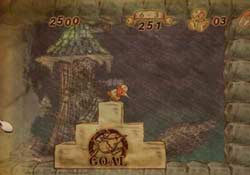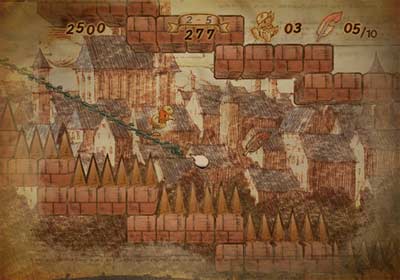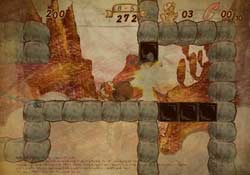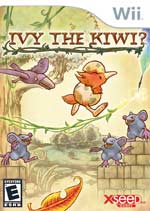Since Yuji Naka of Sonic the Hedgehog fame left Sega in 2006, he hasn’t done much in the vein of platformers, instead using his new development studio to explore other (read: casual) avenues of game design. The collective surprise from among the gaming community for Naka’s Ivy the Kiwi?, then, was big news, at least for the legions of gamers who grew up chasing rings and running through loop-de-loops in the 16-bit era. I actually had a chance to try out Ivy at E3 and was pretty impressed with the results.

Far from a Sonic clone, Ivy is one of those “forward motion” puzzle-style platformers that have seen a bit of a resurgence lately in games like Bit.Trip Runner, Mirror’s Edge iPhone, and the indie favorite Canabalt. Generally, I’m disappointed with platformers that constantly propel you forward, since I enjoy being able to stop and embrace all the nooks and crannies of a game’s design. But Ivy is an unassuming and spirited little game that’s also quite enjoyable, much like the examples noted above, even if you’re not allowed to stop.
Ivy herself is also one of the cutest game mascots on the Wii. Though a certain kawaii factor might turn off some more hardcore gamers, this little bird is too adorable not to love instantly. It’s bad enough the game opens with storybook drawings of Ivy running around still in her eggshell, spilling big teardrops everywhere as she runs this way and that, looking for her lost mother. But rather than coming off as unnatural or overly sugary (the fate of too many cutesy games to count), Ivy’s feel is heartwarming and genuine rather than forced.
The point is, Ivy has a quaint set of sensibilities, from the charm of its presentation to its aesthetics and mechanics. The world Ivy inhabits is made up of simple pencil sketched backdrops and stylized cel-shaded levels and characters, something like a post-Kindergarten Yoshi’s Island with a heavy emphasis on line shading. The Wii renders Ivy quite well, so well you’ll probably wish the game had a zoom option so you could better admire its artistry, though all of its simple effects are subtle and probably not taxing the hardware too much, the game is still pretty impressive to behold.

Gameplay is also relatively simple: running forward through a series of levels, you have to protect Ivy from various dangers and obstacles. The only way to achieve this is by stretching out protective vines that Ivy can run along, half-fly from one object to the next (think Yoshi’s floating jump), or slingshot across a stage with. Vines are drawn on-screen with the Wii Remote and can stretch or be manipulated in real time as Ivy makes her way across them.
The catch is you can only use three vines at once, after which the first drawn disappears, making it essential to keep an eye on where Ivy is in relation to these temporary passages at all times. Bouncing Ivy from one vine to the next is also a skill you’ll need to master, particularly in relation to her relative speed and the vines’ reactive physics. It seems like programming the vines to feel and behave accurately would be a big challenge and certainly one the game’s fun factor would hinge on; luckily, Naka and Prope nailed it.

As with any platformer, things start out easy but ramp up in difficulty after not too long a time. Initially, Ivy’s travels across the game’s first fifty-some stages simply involve getting her from point A to point B without much difficulty. There may be some scattered spikes, but other than bouncing Ivy here or there, it’s relatively easy.

Things don’t stay that way, though. Soon Ivy begins to encounter enemies within the game’s bite-sized stages, which you either have to block off from the near-defenseless bird or deal with by slingshotting Ivy into them with her drill move. Breakable blocks begin to appear (again, you’ll need to use Ivy’s slingshot). Acid drops appear on the ceiling areas of some stages, which have to be blocked by clever vine placement. Then there are other types that can only be broken by “throwing” large rocks across stages alongside the titular bird, which can be pretty tough at times considering the game’s lack of direct control in any object interaction. In the later stages, the game forces you to do a lot of multitasking, simultaneously shielding Ivy from immediate harm while ensuring her path is also safe a few proverbial paces ahead. It can be all too easy to accidentally whirl Ivy into a bed of spikes or some other danger because you were trying to protect Ivy and, for example, form a bridge for her. Should you let any harm befall such a cute little bird, you may feel like a negligent monster. Thankfully, the game’s controller throwing moments are relatively few, though stages involving the use of rocks may severely tax your patience at times (particularly when Ivy lands in front of a rock needed to take out obstacles or enemies).
I have to say, with all the violence and depravity that’s so commonplace in the industry these days, it’s refreshing to come across a game with such an air of innocence. Ivy may not be without its flaws, the biggest being that a seasoned gamer can blow through it in a couple hours and there’s not a whole lot of replay value, but if you have kids that want a quality platformer or you’re just a fan of puzzle-platformers yourself, Ivy’s a good bet.
RATING OUT OF 5 RATING DESCRIPTION 4.0 Graphics
Ivy’s lush visuals use cel-shading to invoke a sense of child-like wonder. 3.8 Control
Controlling the vines works well enough, although the game’s precise physics can be your worst enemy sometimes. No direct interaction with objects can make moving things tricky. 4.0 Music / Sound FX / Voice Acting
The music is catchy and vaguely European and sounds are effective if subtle. Also, there’s no voicework aside from Ivy’s adorable “Eee-vee!” sounds. 3.5
Play Value
Ivy is an enjoyable little game, if one that’s a bit too short. An extra mode and collecting each of the ten feathers from the game’s numerous stages adds replay value, though the stages themselves can be short.
3.5 Overall Rating – Good
Not an average. See Rating legend above for a final score breakdown.
Game Features:
